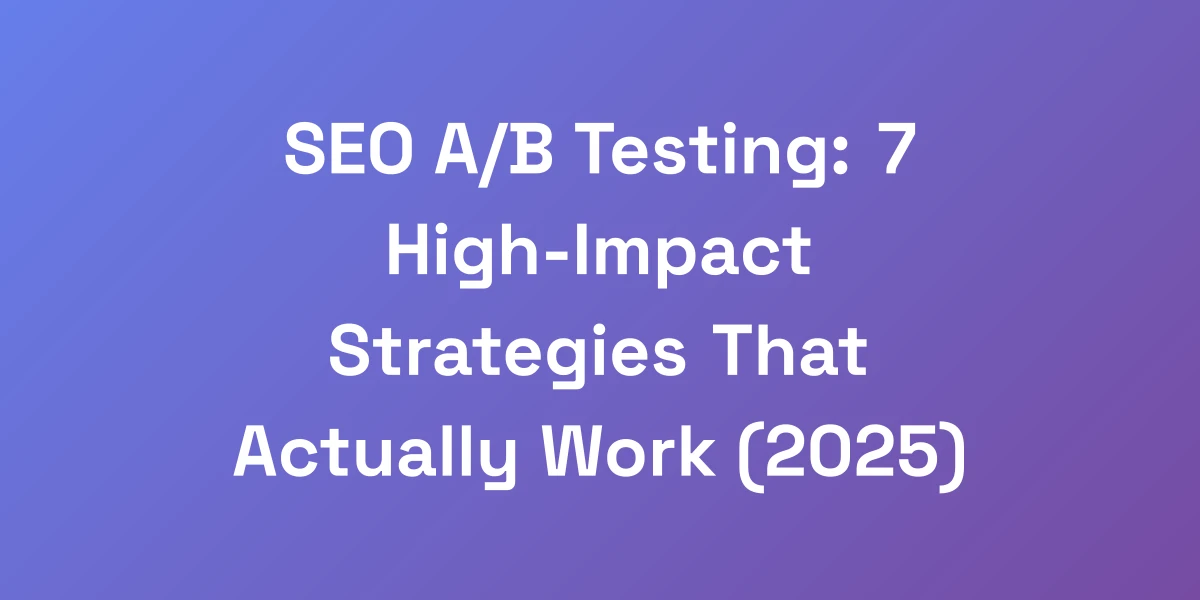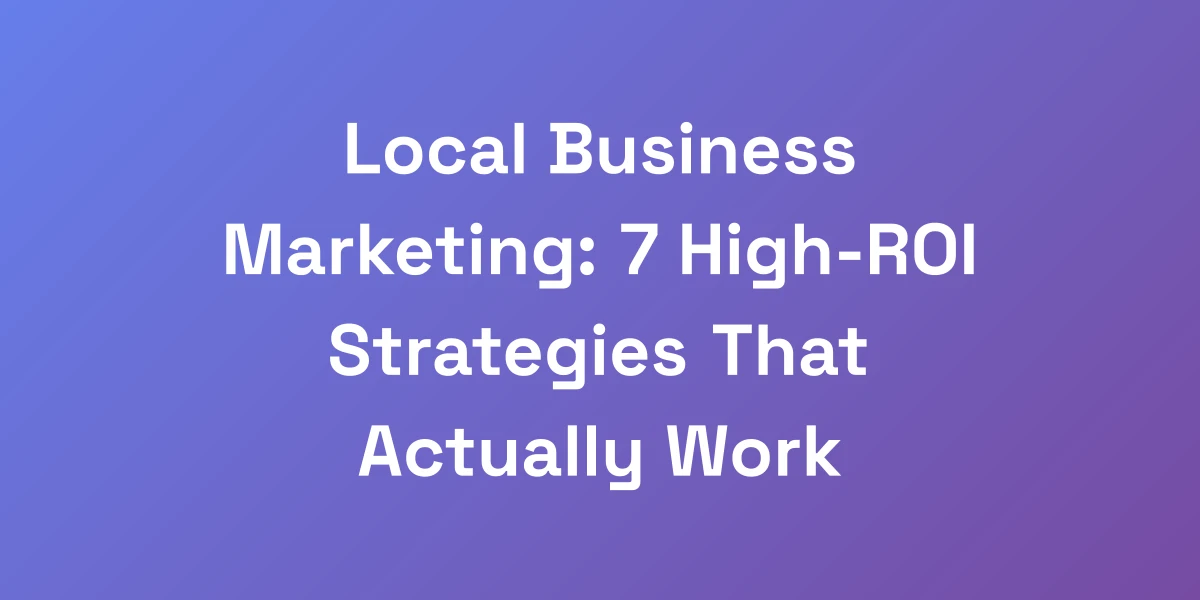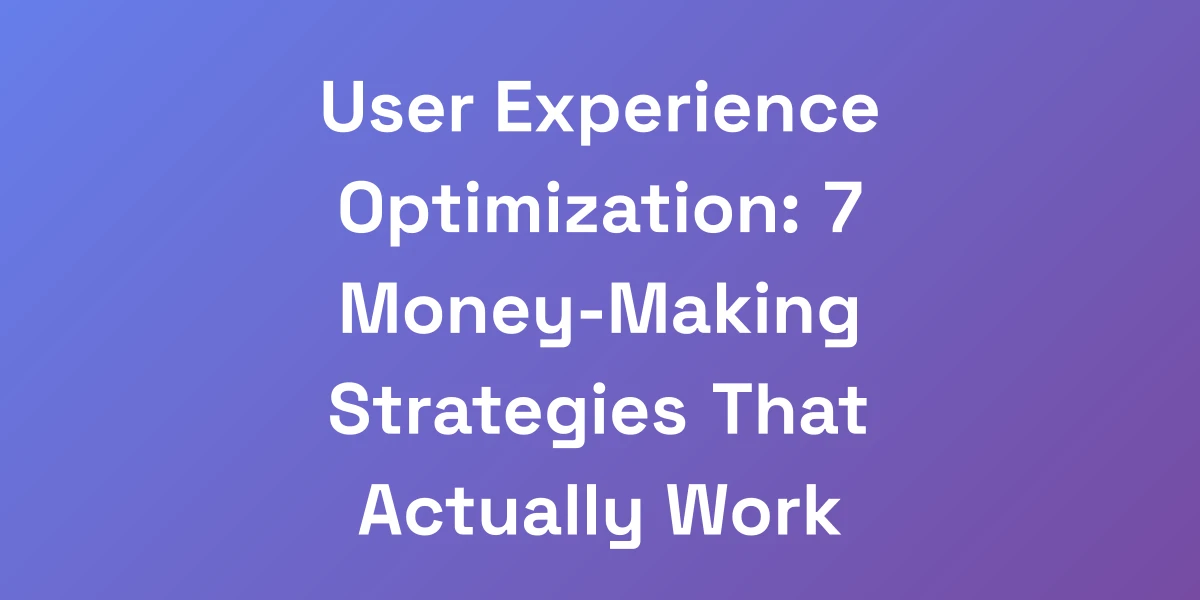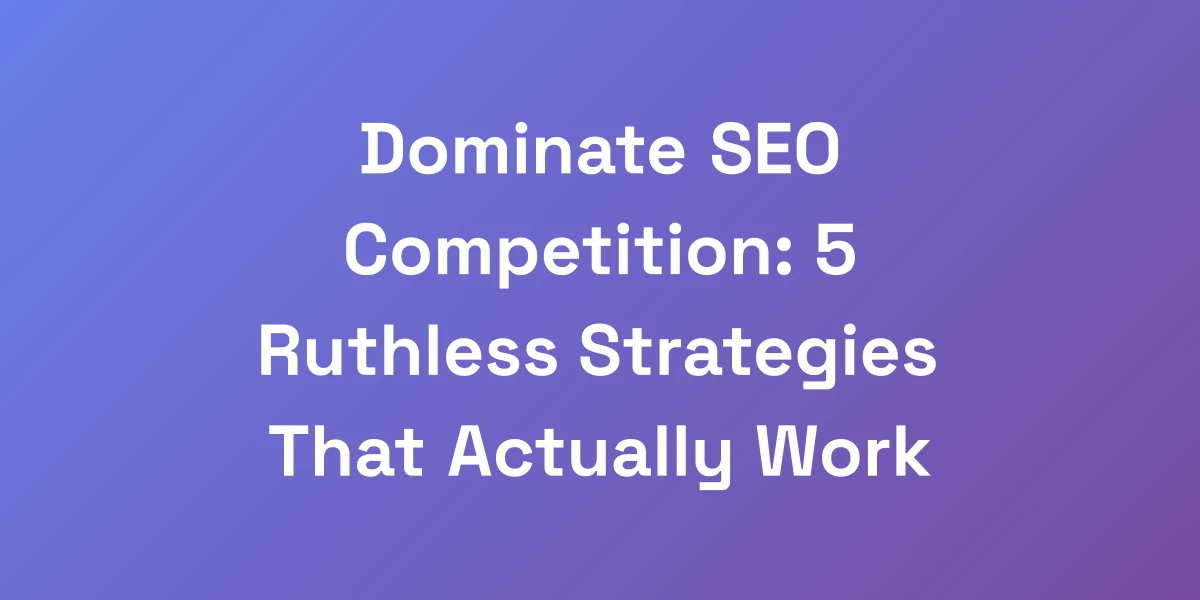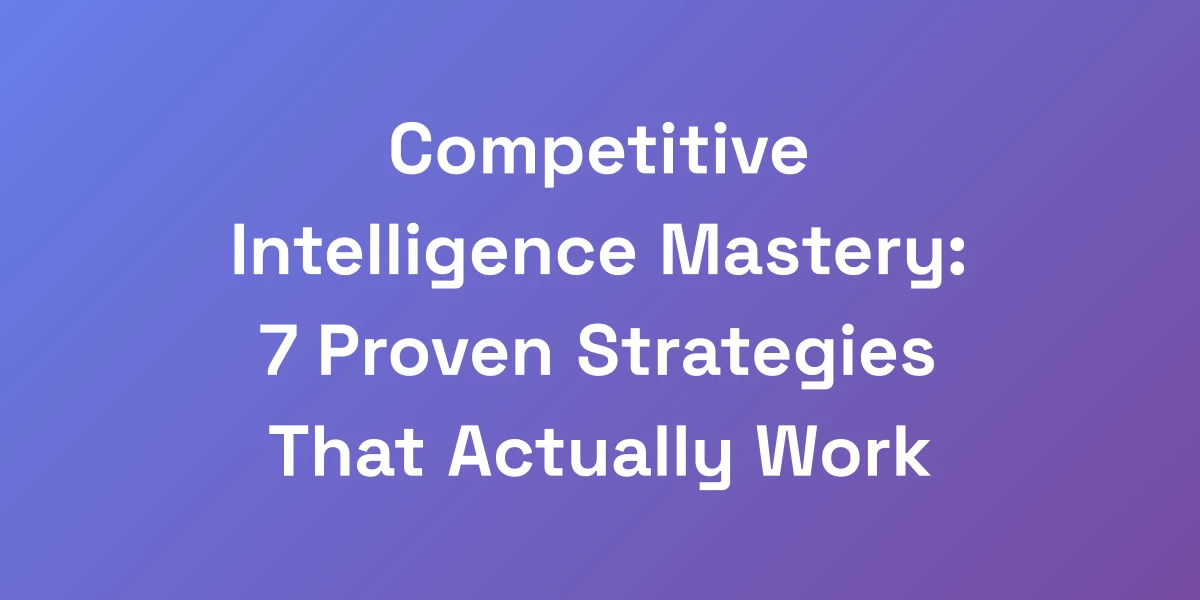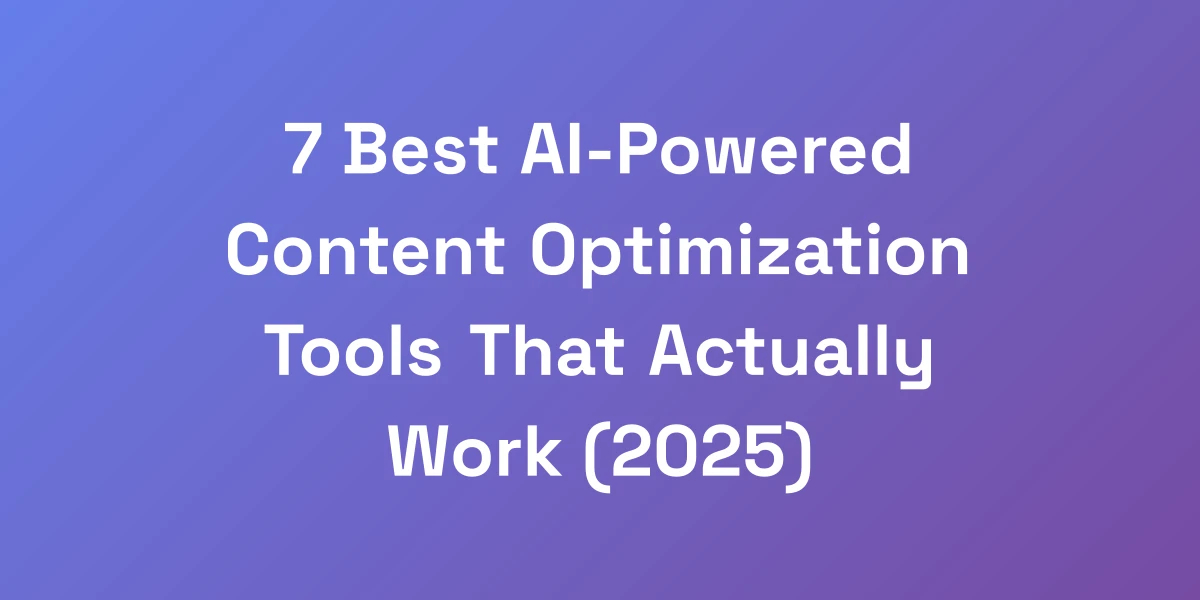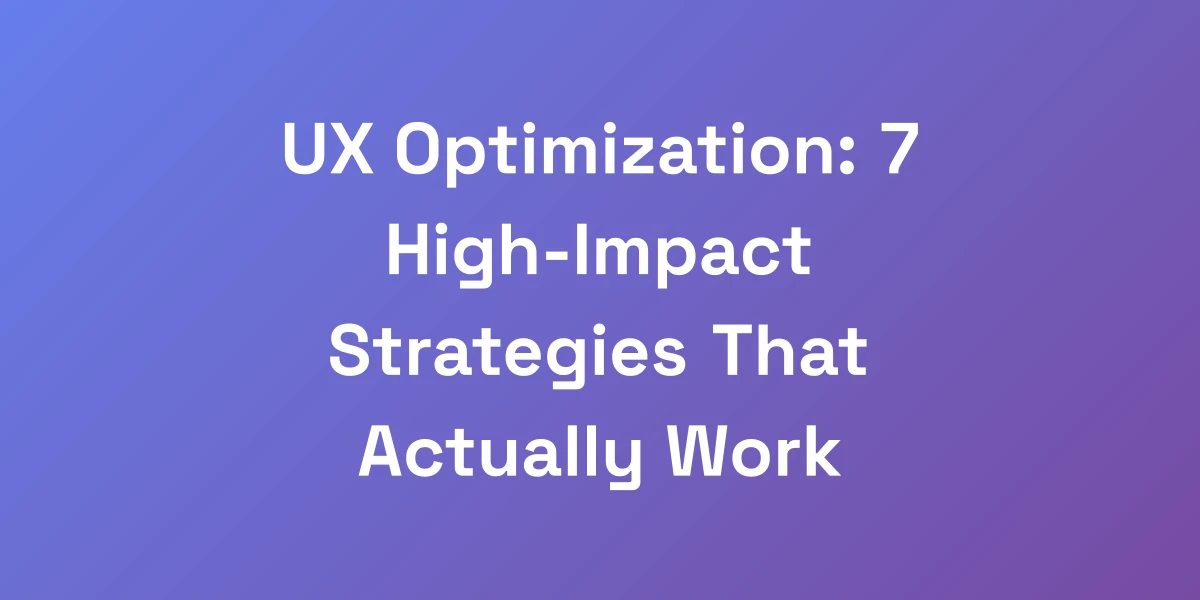
UX Optimization: 7 High-Impact Strategies That Actually Work
Mar 13, 2025 | By [email protected]
Introduction
We’ve all been there. You land on a website, browse a bit, and then bounce faster than a bad check. It’s frustrating, isn’t it? Now, imagine if that website was yours. How much revenue are you tossing out the window because your user experience (UX) isn’t up to par?
Let’s cut to the chase. Most businesses underestimate the power of UX optimization, treating it as a “nice-to-have” instead of the wealth generator it truly is. We’re talking about strategies that don’t just make your site look good—they transform it into a conversion machine.
In this article, we’ll dive deep into seven high-impact UX optimization strategies that actually work. These aren’t fluff tips you can implement in five minutes. These are battle-tested methods that have helped companies like Airbnb and Netflix skyrocket their results. Ready to turn your website into a profit powerhouse? Let’s get into it.
The Hidden ROI of UX Optimization: Why Most Businesses Get It Wrong
Let us hit you with some truth: 90% of businesses are leaving money on the table because they’re treating UX optimization like a ‘nice-to-have’ instead of the profit multiplier it really is. We’ve seen companies 10x their conversion rates by fixing UX issues that took less than a day to implement. Here’s the thing – users don’t just bounce because your product sucks; they bounce because you’re making them think too hard. And in today’s market, cognitive load is the silent conversion killer that’s decimating your bottom line.
The Real Cost of Poor UX (With Shocking Statistics)
When UX is neglected, businesses suffer in ways that aren’t always immediately visible. Consider this:
- ROI on UX Design: For every $1 invested in UX, businesses can see returns ranging from $2 to $100.
- Conversion Rate Boost: Optimizing your checkout design can boost conversion rates by 35.26% for large e-commerce sites.
- Case Studies: Airbnb saw a 30% increase in bookings after redesigning their website to improve user experience.
- Netflix: Continuous UX optimization, particularly through personalized recommendations, has maintained a low churn rate of 2.4%.
These numbers aren’t just impressive—they’re a wake-up call. Ignoring UX means missing out on significant revenue opportunities.
Why Traditional UX Metrics Are Misleading
Most businesses rely on traditional metrics like bounce rates and page views to gauge UX success. But these metrics can be misleading. For example, a high bounce rate on mobile devices might seem bad, but it could indicate that users found what they needed quickly. What matters more is the quality of interactions and whether users achieve their goals.
- Behavioral Metrics: Focus on user satisfaction, task success rates, and ease of navigation.
- Contextual Insights: Understand the why behind the numbers. Use qualitative data to complement quantitative metrics.
The Psychology Behind User Decision-Making
Understanding the psychological triggers that influence user behavior is crucial for effective UX optimization. People make decisions based on emotions and then rationalize them with logic.
- Emotional Design: Create an emotional connection with users through aesthetics and interactive elements.
- Anchoring Effect: Present multiple options to guide users towards the desired action without overwhelming them.
- Social Proof: Incorporate testimonials and reviews to build trust and influence decisions.
How Top Companies Leverage UX for Revenue Growth
Leading companies like Amazon and Google have mastered the art of UX optimization. They continuously iterate their designs based on user feedback and behavior data.
- Amazon: Their relentless focus on UX has set industry standards for e-commerce, driving customer loyalty and retention.
- Google: By simplifying search interfaces and speeding up load times, Google ensures a seamless user experience that keeps users coming back.
- Apple: Intuitive design and consistent user experience across all devices reinforce brand loyalty and premium positioning.
The New UX Optimization Framework for 2025
As we look towards 2025, UX optimization strategies are evolving. The focus is shifting towards more personalized and adaptive experiences.
- AI and Machine Learning: Leveraging AI-powered SEO automation to predict user behavior and personalize experiences in real-time.
- Voice User Interface (VUI):strong> Integrating voice commands for hands-free navigation and accessibility.
- Augmented Reality (AR):strong> Enhancing user interactions with immersive AR experiences.
Rapid-Fire UX Optimization Techniques That Drive Immediate Results
Stop wasting time on minor tweaks that don’t move the needle. We’re going to show you the high-impact strategies that deliver massive results fast. These aren’t your typical ‘make the button bigger’ tips – these are battle-tested strategies that have generated millions in revenue for our clients. The key is focusing on what we call the ‘Maximum Impact Minimum Effort’ (MIME) principle. We’re talking about changes that take hours to implement but can double your conversion rates overnight.
The 5-Second Rule for Homepage Optimization
Your homepage has just five seconds to capture a user’s attention. Here’s how to make every second count:
- Clear Value Proposition: Communicate what you offer and why it matters within the first few seconds.
- Minimalist Design: Avoid clutter. Focus on key elements that guide users towards the next step.
- Compelling Visuals: Use high-quality images or videos that resonate with your target audience.
Actionable Tip: Conduct a quick audit of your homepage. Can a visitor understand your value proposition within five seconds? If not, streamline your messaging and visuals.
Navigation Patterns That Triple User Engagement
Intuitive navigation is the backbone of a great user experience. Here’s how to optimize it:
- Consistent Layouts: Maintain uniform navigation menus across all pages to reduce user confusion.
- Descriptive Labels: Use clear and descriptive labels for menu items instead of generic terms like “Services.”
- Accessible Search: Ensure the search bar is prominently placed and functions accurately.
Actionable Tip: Implement breadcrumb navigation to help users understand their location within your site and easily navigate back to previous pages.
Mobile-First Optimization Techniques
With mobile devices handling nearly 60.66% of website traffic, mobile optimization is no longer optional. Here’s how to get it right:
- Responsive Design: Ensure your website adapts seamlessly to different screen sizes and orientations.
- Touch-Friendly Elements: Make buttons and links easy to tap without accidental presses.
- Streamlined Content: Prioritize essential information and minimize load times to keep mobile users engaged.
Actionable Tip: Test your website on multiple mobile devices to identify and fix any usability issues that could be increasing your bounce rates.
Speed Optimization Secrets of Top-Performing Sites
Website speed is a critical factor in user satisfaction and conversion rates. Here’s how to boost your site’s speed:
- Optimize Images: Compress images without sacrificing quality to reduce load times.
- Minify Code: Remove unnecessary characters from HTML, CSS, and JavaScript files to enhance speed.
- Use Content Delivery Networks (CDNs):strong> Distribute your content across multiple servers worldwide to ensure fast delivery.
Actionable Tip: Use tools like Google PageSpeed Insights to identify and fix speed-related issues on your website.
Micro-Interactions That Drive Macro Results
Micro-interactions are the small, subtle animations or responses that occur when users interact with your site. They may seem minor, but they can significantly enhance user engagement:
- Hover Effects: Provide visual feedback when users hover over buttons or links.
- Loading Animations: Keep users engaged while content is loading with animated indicators.
- Form Validation: Instant feedback on form inputs can reduce errors and improve form completion rates.
Actionable Tip: Implement a favorite feature that allows users to save items effortlessly, enhancing personalization and repeat visits.
Advanced UX Testing Methods Most Companies Never Use
Here’s what nobody tells you about UX testing: most companies are doing it completely wrong. They’re running basic A/B tests and calling it a day. But the real money is in what we call compound testing – where each test builds on the insights of the previous one. We’ve developed a system that combines quantitative data with psychological triggers to create a testing framework that’s produced consistent wins across different industries. Let us show you how to implement it.
The Multi-Variant Testing Framework
Unlike basic A/B testing, multi-variant testing allows you to test multiple variables simultaneously, providing deeper insights:
- Identify Key Variables: Determine which elements (e.g., headlines, images, CTAs) to test.
- Design Variations: Create different versions for each variable to understand their individual and combined impact.
- Analyze Results: Use statistical analysis to determine the most effective combination of variables.
Actionable Tip: Start with two variables and gradually increase complexity as you become more comfortable with the framework.
Heat Mapping and User Session Analysis
Understanding where users click, scroll, and spend time on your site can reveal a lot about their behavior:
- Heat Maps: Visual representations of user interactions highlight areas of high engagement and those that are being ignored.
- User Session Recordings: Watching real user sessions helps identify pain points and areas for improvement.
- Scroll Depth Analysis: Determine how far users scroll on each page to assess content effectiveness.
Actionable Tip: Use heat mapping tools like Hotjar or Crazy Egg to gather data and make informed design decisions based on actual user behavior.
Psychological Trigger Testing
Incorporating psychological triggers into your UX can significantly influence user behavior and conversions:
- Scarcity: Display limited-time offers to create a sense of urgency.
- Social Proof: Showcase testimonials and user reviews to build trust.
- Reciprocity: Offer something valuable for free, like an e-book or discount, to encourage users to take action.
Actionable Tip: Test different psychological triggers on key pages to see which ones resonate most with your audience and drive the desired actions.
User Journey Optimization
Mapping out and optimizing the entire user journey ensures a seamless experience from start to finish:
- Identify Touchpoints: Determine all the points where users interact with your brand.
- Streamline Processes: Remove unnecessary steps that could cause friction or drop-offs.
- Personalize Experiences: Tailor interactions based on user data to make the journey more relevant and engaging.
Actionable Tip: Create detailed user personas and journey maps to understand and optimize each stage of the user experience.
Conversion Path Analysis
Analyzing the paths users take to convert can uncover opportunities to enhance UX and boost conversions:
- Identify Common Paths: Determine the most frequent routes users take before converting.
- Spot Drop-Off Points: Find where users abandon their journey and address the underlying issues.
- Optimize Pathways: Simplify and enhance key pathways to make the conversion process smoother.
Actionable Tip: Use analytics tools like Google Analytics or Mixpanel to track and analyze user paths, and implement changes based on your findings to improve conversion rates.
The UX Optimization Tech Stack That 10x’s Results
Listen, you don’t need 50 different tools to optimize your UX. What you need is the right stack that gives you actionable insights without analysis paralysis. We’re going to share the exact tools we use to generate millions in additional revenue for our clients. This isn’t about having the most expensive tools – it’s about having the right ones that work together to give you a complete picture of user behavior and quick wins.
Essential Analytics Tools for UX Optimization
Analytics are the foundation of effective UX optimization. Here are the must-have tools:
- Google Analytics: Provides comprehensive data on user behavior, traffic sources, and conversion metrics.
- Mixpanel: Offers advanced tracking and segmentation to understand user interactions in detail with SEO optimization automation.
- Hotjar: Combines heat maps with user session recordings for a visual understanding of user behavior.
Actionable Tip: Integrate Google Analytics with Hotjar to get both quantitative and qualitative insights into your user experience.
User Behavior Tracking Software
Understanding how users navigate your site is crucial for optimization:
- Mouseflow: Tracks mouse movements, clicks, and scrolls to monitor user engagement.
- Crazy Egg: Provides heat maps and A/B testing features to analyze user behavior and test changes.
- FullStory: Records user sessions and offers robust search and filtering capabilities to find specific interactions.
Actionable Tip: Use session recording tools to watch how real users interact with your site, identifying pain points and areas for improvement.
A/B Testing Platforms Worth Your Money
A/B testing is essential for validating UX changes. Here are top platforms that deliver reliable results:
- Optimizely: Known for its robust features and ease of use, perfect for comprehensive A/B testing.
- VWO (Visual Website Optimizer):strong> Offers a range of testing options, including split URL and multivariate testing.
- Unbounce: Specializes in landing page optimization with A/B testing capabilities.
Actionable Tip: Start with simple A/B tests to validate significant changes before moving on to more complex multivariate tests.
Heat Mapping and Session Recording Tools
Visual data from heat maps and session recordings can uncover user behavior patterns:
- Hotjar: Combines heat maps, session recordings, and surveys to gather comprehensive user insights.
- Crazy Egg: Offers detailed heat maps and scroll tracking to see where users are focusing their attention.
- Mouseflow: Provides in-depth session recordings and heat maps to analyze user interactions.
Actionable Tip: Regularly review heat maps and session recordings to identify and address common user frustrations or confusion points.
Automation Tools for UX Implementation
Automation can streamline the implementation of UX improvements, saving time and reducing errors:
- Zapier: Connects different apps and automates workflows, enabling seamless data transfer and task automation.
- Integromat: Offers advanced automation capabilities for integrating various tools and services.
- HubSpot: Combines CRM with marketing automation, making it easier to manage and optimize user interactions.
Actionable Tip: Use automation tools to sync data between your analytics and CRM systems, ensuring you have up-to-date insights for continuous UX optimization.
Conclusion
We’ve walked through seven high-impact UX optimization strategies that can transform your website from a bounce machine to a conversion powerhouse. From understanding the hidden ROI of UX to implementing rapid-fire techniques and leveraging advanced testing methods, each strategy is designed to deliver tangible results.
The key takeaway? Investing in UX isn’t just about making your site look good—it’s a strategic move that can significantly boost your revenue and customer satisfaction. Don’t leave money on the table by overlooking the power of UX optimization.
Ready to take your UX to the next level? Start implementing these strategies today and watch your conversion rates soar. Have questions or want to share your own UX success stories? Join the conversation in the comments below and let’s optimize together.
